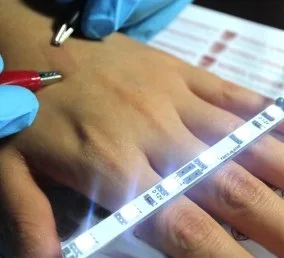An ultrathin, transparent and conductive film has been produced using a ‘cheap and simple’ method, by researchers from the University of Illinois at Chicago and Korea University.
The film is formed of a ‘mat’ of tangled nanofibre, which is electroplated to a form a selfjunctioned copper nano-‘chicken wire’. The product can be flexed and stretched, and is thought to have potential uses in roll-up touchscreens and wearables.
Electrical resistance is ‘at least 10-fold’ lower than the previous existing record holder, said study author Sam Yoon. It also retains its properties after repeated cycles of stretched and bending.
To manufacture the film, the researchers electrospun a nanofibre mat of polyacrylonitrile (PAN); these fibres are about 1/100 the diametre of a human hair. The fibre spins out in a spiral cone. Fractal loops are formed in flight when the fibre is spun, so it loops back on itself. When deposited on a surface, the fibre intersects itself “a million times,” said UIC professor Alexander Yarin.
This naked polymer is not conductive. It is spatter-coated with metal to attract metal ions and then electroplated with copper, silver, nickel or gold. The self-fusion of plating at the fibre junctions “dramatically reduced the contact resistance,” Yarin said. The metal-plated junctions also aided percolation of the electric current, and account for the nanomaterial’s physical resiliency.
Both the spinning and coating processes are ‘relatively high-throughput’ and commercially viable. After being coated, the fibres can be taken and transferred to ‘any’ surface – even a leaf. Most of the layer – 92% – is holes, making it transparent.

